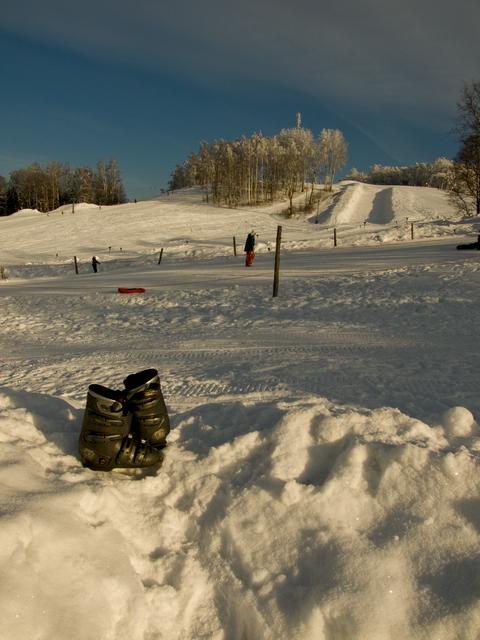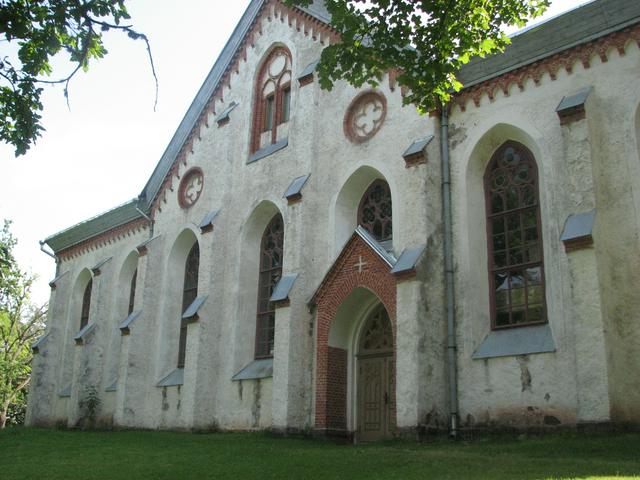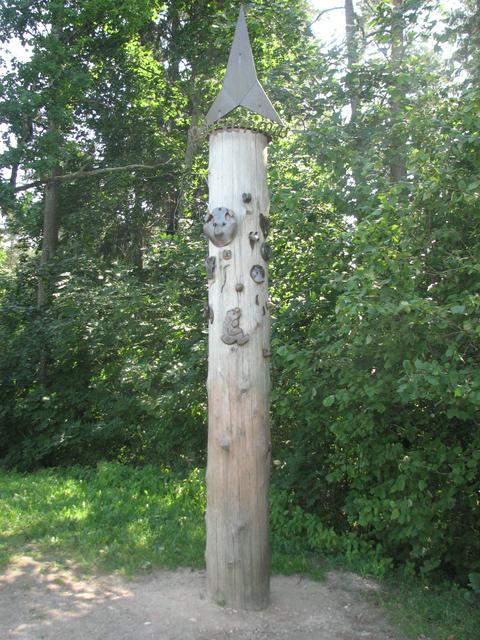Otepää is a small town with 2,000 inhabitants set in the hills of south Estonia, approximately 50 km south from Tartu.
 Otepää is one of the oldest settlements in Estonia, first mentioned in the Russian chronicles in 1116. Its name was derived from the shape of the Town Hill (Linnamägi), resampling a bear head, meaning Oti pää in Estonian. It's also where in 1224, Bishop Hermann started building the first known brick castle in Estonia, The Stone Fort.
Otepää is one of the oldest settlements in Estonia, first mentioned in the Russian chronicles in 1116. Its name was derived from the shape of the Town Hill (Linnamägi), resampling a bear head, meaning Oti pää in Estonian. It's also where in 1224, Bishop Hermann started building the first known brick castle in Estonia, The Stone Fort.
Otepää is the best known winter sports centre in the Baltics and the Winter Capital of Estonia.
For more information see: http://www.otepaa.eu
- Tourist Information Centre, Tartu mnt 1, +372 7661200. M-F 10:00-17:00, Sa-Su 10:00-14:00. Numerous brochures and maps on activities available depending on the season. Also sells some souvenirs. Alternative email address: turism@otepaa.eu
Tourist Information Centre, Tartu mnt 1, +372 7661200. M-F 10:00-17:00, Sa-Su 10:00-14:00. Numerous brochures and maps on activities available depending on the season. Also sells some souvenirs. Alternative email address: turism@otepaa.eu

- Otepää Town Hill and Bishop's Castle ruins. Observe the ruins of the bishop's castle. The hill (165.6 m NN) emerged about 13,000 years ago during the Ice Age. Then, 1000 years ago the most important castle in ancient Ugala was built here. A permanent fortified settlement was built in the 7–8th century, and significantly strengthened in the 11th century. The oldest known firearm in the world was found here. During the battles of 1208-1227, most of the fighting took place around the castle. It was overtaken in 1224 by the crusaders, after which Herman I built the first stone castle here, which was also one of the first brick buildings in Estonia. Unfortunately, today only a few walls have remained on top of the hill.
- St. Mary's Lutheran Church. Neo-Gothic and 51 m in height. Constructed in 1671, and repaired in 1850 including a new choir balcony. The pipe organ was built in 1852 in Tartu by Kessler. The church tower was built in 1860. And the façade was done during a total reconstruction in 1890. The lock of the door dates back to 1772. The new bell was a gift from the Wihti parish in Finland in 1992.
- Stone Labyrinth and Energy Centre. This place includes a Golden Ratio Stone Spiral, a Chartres Labyrinth, and a tepee – a conical tent. Labyrinths have been used for gaining energy and walking meditation. The labyrinth has 11 path and is 11 m in diameter, and a copy of the famous Chartres labyrinth in France.

- Energy pillar. In 1992, this wooden pillar of positive energy fields was erected. Location and seats were chosen with greatest sensibility. In 1993, the pillar was decorated by participants of the Worldwide Smiths Day. It is believed that when you stand in the right place and afterwards touch it, it will give you a great shot of energy and good health.
- Otepää Ski and Estonian Flag museums, +372 7663670, +372 5040424. Museum on the history of the flag of Estonia, of which the city of Otepää was important in its creation.
- Winter sports museum. W-Fr 11–17:00, Sa-Su 11–16:00. A small museum on the history of performances of Estonian athletes in winter sports. €1.
Otepää Town Hill and Bishop's Castle ruins. Observe the ruins of the bishop's castle. The hill (165.6 m NN) emerged about 13,000 years ago during the Ice Age. Then, 1000 years ago the most important castle in ancient Ugala was built here. A permanent fortified settlement was built in the 7–8th century, and significantly strengthened in the 11th century. The oldest known firearm in the world was found here. During the battles of 1208-1227, most of the fighting took place around the castle. It was overtaken in 1224 by the crusaders, after which Herman I built the first stone castle here, which was also one of the first brick buildings in Estonia. Unfortunately, today only a few walls have remained on top of the hill.
St. Mary's Lutheran Church. Neo-Gothic and 51 m in height. Constructed in 1671, and repaired in 1850 including a new choir balcony. The pipe organ was built in 1852 in Tartu by Kessler. The church tower was built in 1860. And the façade was done during a total reconstruction in 1890. The lock of the door dates back to 1772. The new bell was a gift from the Wihti parish in Finland in 1992.
Stone Labyrinth and Energy Centre. This place includes a Golden Ratio Stone Spiral, a Chartres Labyrinth, and a tepee – a conical tent. Labyrinths have been used for gaining energy and walking meditation. The labyrinth has 11 path and is 11 m in diameter, and a copy of the famous Chartres labyrinth in France.
Energy pillar. In 1992, this wooden pillar of positive energy fields was erected. Location and seats were chosen with greatest sensibility. In 1993, the pillar was decorated by participants of the Worldwide Smiths Day. It is believed that when you stand in the right place and afterwards touch it, it will give you a great shot of energy and good health.
Otepää Ski and Estonian Flag museums, +372 7663670, +372 5040424. Museum on the history of the flag of Estonia, of which the city of Otepää was important in its creation.
Winter sports museum. W-Fr 11–17:00, Sa-Su 11–16:00. A small museum on the history of performances of Estonian athletes in winter sports. €1.
- Lake Pühajärve. Part of the Otepää recreational region with an area of 2,859 km². Trails along the lake provide access to the banks and picnic areas. It is possible to rent a boat to reach the islands on the lake, which are uninhabited. In winter, the frozen lake allows for ice skating or cross-country skiing, depending on snow conditions.
- Monument of the visit of Dalai-Lama.
- Harimäe viewing tower. Beautiful views from observation towers on top of Harimägi hill. 28 m height in total, with the highest platform at 24 m.
Lake Pühajärve. Part of the Otepää recreational region with an area of 2,859 km². Trails along the lake provide access to the banks and picnic areas. It is possible to rent a boat to reach the islands on the lake, which are uninhabited. In winter, the frozen lake allows for ice skating or cross-country skiing, depending on snow conditions.
Monument of the visit of Dalai-Lama.
Harimäe viewing tower. Beautiful views from observation towers on top of Harimägi hill. 28 m height in total, with the highest platform at 24 m.
- If you don't like crowds and sports then it's always possible to go on hiking trips through the surrounding the picturesque landscapes, and you could try an Estonian hot smoke sauna and bathing in an icy lake afterwards.
During summertime you can see the landscape of rolling hills and lakes, romantic winding village roads and small rivers. You can also take part in different sports or simply have a good time at lake Pühajärve, which is a jewel among Estonian lakes.
- Tehvandi Ski Jumping Tower. In winter only open upon request.. Beautiful views from this observation towers on top of the Tehvandi hill. €2.
- Otepää Nature Park. Hike along the paths of the park.
- Saku Suverull – A summer competition for the world's best skiers.
- Leigo Lake Music Festival, near Otepää. August. Open-air concerts are held in completely natural venues on the hilly landscapes of the Otepää highland. The musicians' stage is on an island in the lake, surrounded by thousands of listeners on the sloping shore.
Tehvandi Ski Jumping Tower. In winter only open upon request.. Beautiful views from this observation towers on top of the Tehvandi hill. €2.
Otepää Nature Park. Hike along the paths of the park.
Saku Suverull – A summer competition for the world's best skiers.
Leigo Lake Music Festival, near Otepää. August. Open-air concerts are held in completely natural venues on the hilly landscapes of the [[Otepää]] highland. The musicians' stage is on an island in the lake, surrounded by thousands of listeners on the sloping shore.
In wintertime, Otepää is a winter sports paradise for skiers, snowmobile riders and for anyone who enjoys the snow: there are slalom slopes equipped with elevators and lots of cross-country tracks.
- Alpine skiing – Munakas Sport Resort ; slopes in Kuutsemäe Holiday Center (Kuutsemäe Puhkekeskus ])
- Cross-country skiing – Otepää is the capital of cross-country skiing in Estonia. All the trails leave from the stadium of the city. A circuit of 2.5 km of track around the stadium is sometimes maintained with snow stored when melted elsewhere. The map of the tracks around the city is available at the tourist office. The biggest track is the Otepää-Tartu marathon, which runs 63 km between the two cities and is open to the public except during the marathon. Another related event is the FIS World Cup Otepää Competition.
- An ice-fishing competition, called "Golden Fish", draws the crowds.
- Ice Skating on the lake. Depending on the conditions, the lake Pühajärv is sometimes frozen but not covered with snow. It is then possible to rent skates on the shore. Bypassing the building that houses the spa hotel north of the lake you will find a weight room that also rents cross-country skis and lake skates.
- Snow tube, Linnamäe tee 1, +372 5205611. M–F 10–19:00, Sa 10–20:00, Su 10–18:00. The place has a mechanical lift allowing to go down slopes on a kind of plastic buoy. The track is sometimes artificially snowed. €6.
- Snow scooter. This activity can be done on snow or ice. Cross-country ski trails and trails can be reached on a frozen lake. It is possible to rent the equipment in Suusarent.
* Suusarent. M–F 10–18:00, Sa–Su 10–21:00. If staff is not in the shop during business hours, please contact the tourist office directly opposite.. Rental of snowboards, cross-country skis, snow scooters and other winter sports equipment. Friendly and efficient owner who can provide information on snow and ice conditions.
Alpine skiing – Munakas Sport Resort ; slopes in Kuutsemäe Holiday Center (Kuutsemäe Puhkekeskus ])
Cross-country skiing – Otepää is the capital of cross-country skiing in Estonia. All the trails leave from the stadium of the city. A circuit of 2.5 km of track around the stadium is sometimes maintained with snow stored when melted elsewhere. The map of the tracks around the city is available at the tourist office. The biggest track is the Otepää-Tartu marathon, which runs 63 km between the two cities and is open to the public except during the marathon. Another related event is the FIS World Cup Otepää Competition.
An ice-fishing competition, called "Golden Fish", draws the crowds.
Ice Skating on the lake. Depending on the conditions, the lake Pühajärv is sometimes frozen but not covered with snow. It is then possible to rent skates on the shore. Bypassing the building that houses the spa hotel north of the lake you will find a weight room that also rents cross-country skis and lake skates.
Snow tube, Linnamäe tee 1, +372 5205611. M–F 10–19:00, Sa 10–20:00, Su 10–18:00. The place has a mechanical lift allowing to go down slopes on a kind of plastic buoy. The track is sometimes artificially snowed. €6.
Snow scooter. This activity can be done on snow or ice. Cross-country ski trails and trails can be reached on a frozen lake. It is possible to rent the equipment in Suusarent.
* Suusarent. M–F 10–18:00, Sa–Su 10–21:00. If staff is not in the shop during business hours, please contact the tourist office directly opposite.. Rental of snowboards, cross-country skis, snow scooters and other winter sports equipment. Friendly and efficient owner who can provide information on snow and ice conditions.
If you don't like crowds and sports then it's always possible to go on hiking trips through the surrounding the picturesque landscapes, and you could try an Estonian hot smoke sauna and bathing in an icy lake afterwards.
- Rae Kebab, Lipuväljak 13, +372 58405353. Su–Th 11:00–20:00, F–Sa 11:00–06:00. €.
- Oti Pubi, Lipuväljak 26, +372 7668977 (for orders), +372 55546200 (for reservations). M–Su 10–00:00. Pub and restaurant (pizza, etc.). €€.
Rae Kebab, Lipuväljak 13, +372 58405353. Su–Th 11:00–20:00, F–Sa 11:00–06:00. €.
Oti Pubi, Lipuväljak 26, +372 7668977 (for orders), +372 55546200 (for reservations). M–Su 10–00:00. Pub and restaurant (pizza, etc.). €€.
- Coffee at the stadium. 11–17:00.
Coffee at the stadium. 11–17:00.
- Sangaste and the nearby Sangaste Castle, just a few kilometres south.
- Tartu – Museum-rich and hanseatic city on the banks of the Emajõgi River. Also, Estonia's second-largest and oldest city, intellectual hub famous for its universities, and a lively student city.
- Valga – A town on the border with Latvia, where it literally grows into the Latvian town of Valka.
- Viljandi – A beautiful, ancient and hilly city, known for its annual Viljandi Folk Music Festival, beautiful old town and overwhelming and picturesque park around the old castle.
- Võru – A picturesque town not far from the highest hill in the Baltic states, Suur Munamägi. The birthplace of the writer Kreutzwald and the dialect of the Estonian language.
